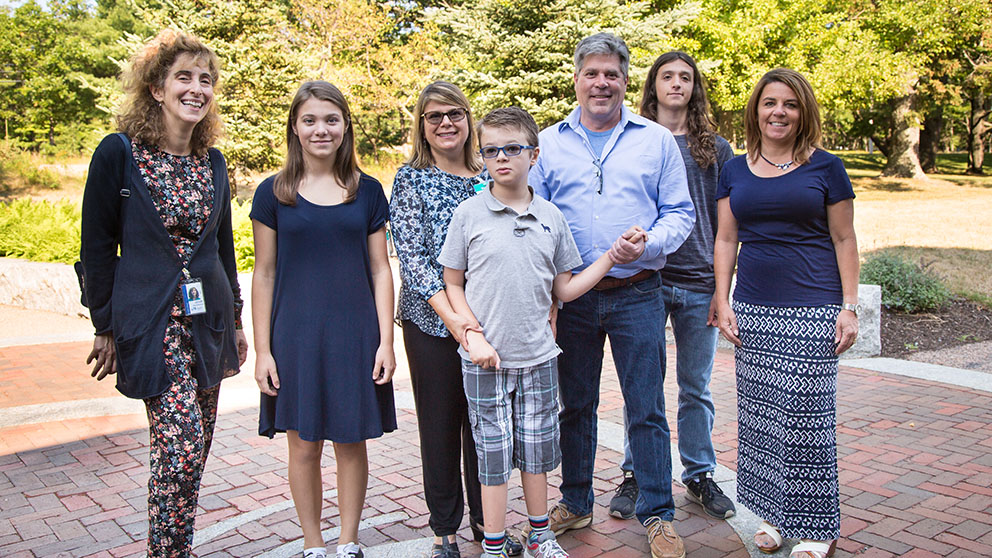
Conner Raymond (center) and family visit with Cat Lutz, Ph.D. at The Jackson Laboratory in Bar Harbor, Maine. When Raymond was 5, he was one of only a handful in the country diagnosed with Snyder-Robinson Syndrome. JAX photo by Tiffany Laufer.
Two new models created to study neurological developments in SRS, advance global understanding of this rare disease
The Jackson Laboratory (JAX), an independent nonprofit biomedical research institute, and The Snyder-Robinson Foundation are pleased to announce that two new mouse models are now available for the study of Snyder-Robinson Syndrome (SRS) and for broader studies of neurological development.
- Stock Number 031170 C57BL/6J-Smsem2Lutzy/JSmsG56S CRISPR/Cas9-generated mutant of the Sms gene carries the G56S point mutation. This strain may be useful in studies related to Snyder-Robinson syndrome.
- Stock Number 032064 C57BL/6J-Smsem6Lutzy/JSmsflox CRISPR/Cas9 generated mutant of the Sms gene carries a floxed exon 5. This conditional knock-out strain will allow for studies at a specific stage of development in distinct tissues such as brain or muscle, while the rest of the mouse remains healthy.
SRS is an ultra-rare genetic disorder that is caused by a mutation in the SMS gene, disrupting the normal functions of the polyamine pathway. SRS is characterized by intellectual disability, seizure disorders, hypotonia, osteoporosis, gastrointestinal issues and a host of other medical problems. Its effects can be devastating. Fewer than fifty cases have been diagnosed in the United States, and fewer than one hundred cases have been diagnosed worldwide.
“We are very grateful for the tremendous contribution that Cat Lutz, Ph.D.The primary research goals of the Lutz lab involve developing preclinical mouse models of neurodegeneration to test therapeutics and inform clinical trials.Cat Lutz, Ph.D. and Aamir Zuberi, Ph.D. of The Jackson Laboratory have made to SRS research,” said Michael Raymond, Executive Director of the Snyder-Robinson Foundation. “We’re also very optimistic that these models will soon help researchers develop treatments for individuals struggling with SRS. This incredible gift of SRS knock-out models is especially important to our research because our community is so small, making it difficult to raise funds for research.”
In addition to developing the SRS models, Dr. Zuberi has continued to actively participate in ongoing discussion with polyamine researchers who have been exploring various ways to correct polyamine levels in the cells of SRS patients.
“The Jackson Laboratory is committed to helping families affected by all diseases – including the rarest ones – by advancing mouse model generation and therapeutic strategies to help identify causes and direct future treatments. JAX continues to work with the global scientific community to explore innovative ways to advance these efforts. We are always delighted to see the impact a single mouse model can have in moving a foundation closer to their goal,” said Lutz.
These new models, available immediately to the worldwide scientific community, are two of the latest additions to JAX’s extensive collection. The Laboratory is the world's source for more than 11,500 strains of genetically defined mice, is home of the Mouse Genome Informatics and Mouse Phenome databases, and is a hub for scientific courses, conferences, training and education.
About The Snyder-Robinson Foundation
The mission of The Snyder-Robinson Foundation is to advance knowledge and understanding of Snyder-Robinson Syndrome discovery with the central of goal finding a cure or treatments that will improve the quality of life of SRS patients.
About The Jackson Laboratory
The Jackson Laboratory (www.jax.org) is an independent, nonprofit biomedical research institution with more than 2,200 employees. Headquartered in Bar Harbor, Maine, it has a National Cancer Institute-designated Cancer Center, facilities in Ellsworth, Maine and Sacramento, Calif., and a genomic medicine institute in Farmington, Conn. Its mission is to discover precise genomic solutions for disease and empower the global biomedical community in the shared quest to improve human health.